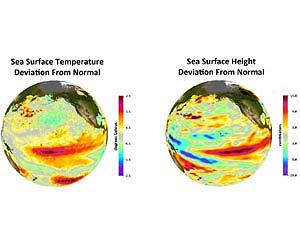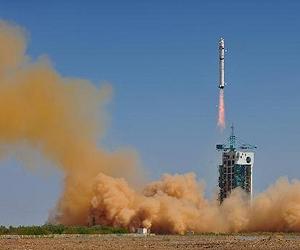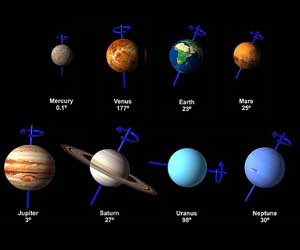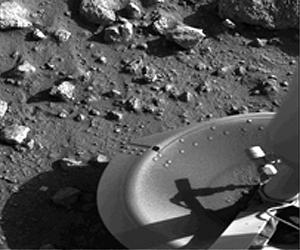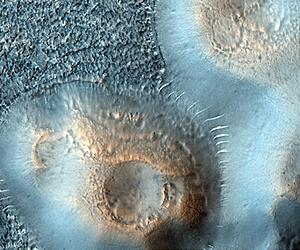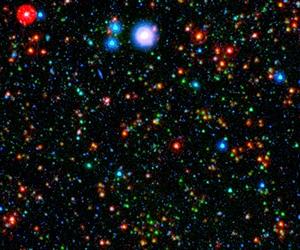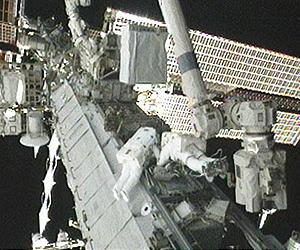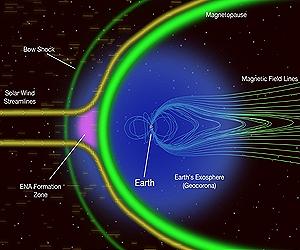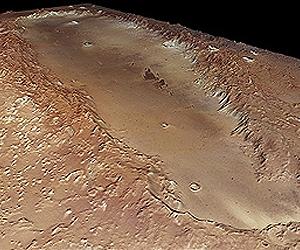 Orcus Patera is an enigmatic elliptical depression located between the volcanoes of Elysium Mons and Olympus Mons. This well-defined depression extends approximately 380 by 140 kilometres in a north-northeast to south-southwest direction. It has a rim that rises up to 1800 metres above the surrounding plains, while the floor of the depression lies 400 to 600 metres below the surroundings. Credit: ESA/DLR/FU Berlin (G. Neukum). |
Bonn, Germany (SPX) Aug 30, 2010
Orcus Patera is an enigmatic elliptical depression near Mars's equator, in the eastern hemisphere of the planet. Located between the volcanoes of Elysium Mons and Olympus Mons, its formation remains a mystery. Often overlooked, this well-defined depression extends approximately 380 by 140 kilometres in a north-northeast to south-southwest direction.
It has a rim that rises up to 1800 metres above the surrounding plains, while the floor of the depression lays 400 to 600 metres below the surroundings.
The High-Resolution Stereo Camera (HRSC) on board the European Space Agency's Mars Express orbiter acquired the images during Mars Express orbits 2216 and 2238.
The images show an area centred at approximately 14 degrees N / 177 degrees E, and have a ground resolution of about 30 metres per pixel. The camera is operated by the German Aerospace Center (Deutsches Zentrum fur Luft- und Raumfahrt; DLR).
The term 'patera' is used for deep, complex or irregularly shaped volcanic craters such as the Hadriaca Patera and Tyrrhena Patera at the north-eastern margin of the Hellas impact basin. However, despite its name and the fact that it is positioned near volcanoes, the actual origin of Orcus Patera remains unclear.
Aside from volcanism, there are a number of other possible origins. Orcus Patera may be a large and originally round impact crater, subsequently deformed by compressive forces.
Alternatively, it could have formed after the erosion of aligned impact craters. However, the most likely explanation is that it was made in an oblique impact, when a small body struck the surface at a very shallow angle, perhaps less than five degrees above the horizontal.
The existence of tectonic forces at Orcus Patera is evident from the presence of the numerous 'graben', rift-valley-like structures that cut across its rim. Up to 2.5 kilometres wide, these graben are oriented roughly east-west and are only visible on the rim and the nearby surroundings.
Within the Orcus Patera depression itself, the large graben are not visible, probably having been covered by later deposits. But smaller graben are present, indicating that several tectonic events have occurred in this region and also suggesting that multiple episodes of deposition have taken place.
The occurrence of 'wrinkle ridges' within the depression proves that not only extensional forces, as would be needed to create graben, but also compressive forces shaped this region. Wind-driven processes probably formed the dark shapes near the centre of the depression, where dark material excavated by small impact events in the depression has been redistributed.
However, the presence of graben and wrinkle-ridges has no bearing on the origin of Orcus Patera, as both can be found all over Mars. The true origin of Orcus Patera remains an enigma.
The High Resolution Stereo Camera (HRSC) experiment on the European Space Agency's Mars Express mission is led by the Principal Investigator (PI) Prof. Dr Gerhard Neukum, who was also responsible for the technical design of the camera. The science team of the experiment consists of 45 Co-Investigators from 32 institutions and 10 nations.
The camera was developed at the German Aerospace Center (DLR) under the leadership of the PI, G. Neukum, and built in cooperation with industrial partners (EADS Astrium, Lewicki Microelectronic GmbH and Jena-Optronik GmbH).
The experiment on Mars Express is operated by the DLR Institute of Planetary Research, through ESA/ESOC. The systematic processing of the HRSC image data is carried out at DLR. The scenes shown here were processed by the PI-group at the Institute for Geosciences of the Freie Universitat Berlin in cooperation with the DLR Institute of Planetary Research, Berlin.
www.marsdaily.com

